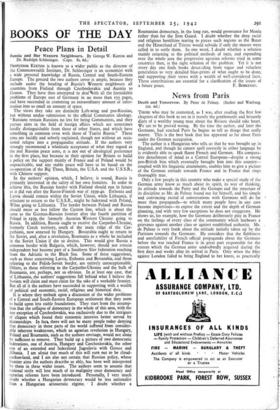BOOKS OF THE DAY
Peace Plans in Detail
PROFESSOR KEETON is known to a wider public as the director of the Commonwealth Institute, Dr. Schlesinger is an economist with a wide personal knowledge of Russia, Central and South-Eastern Europe. The ground the two authors cover is ample, because they include under the heading of Russia's Western neighbours all countries from Finland through Czechoslovakia and Austria to Greece. They have thus attempted to deallvith all the formidable problems of Europe east of Germany in no more than 155 pages, and have succeeded in cramming an extraordinary amount of infor- mation into so small an amount of space.
The views they take are distinctly Left-wing and pro-Russian, but without undue submission to the official Communist ideology. "Russians remain Russians no less for being Communists, and they pursue aims in the field of foreign affairs which are sometimes hardly distinguishable from those of other States, and which have something in common even with those of Tsarist Russia." These aims are lucidly and soberly explained, though not without an occa- sional relapse into a propagandist attitude. If the authors very strongly recommend a wholesale acceptance of what they regard as the real Russian peace arms, it is not out of ideological preference in the first place, but because in their opinion for Britain to build a policy on the support mainly of France and of Poland would be unpracticable, and any stable peace will have to be based on the co-operation 9f the Big Three, Britain, the U.S.A. and the U.S.S.R., with Chinese support.
In the authors' opinion, which, I believe, is sound, Russia is primarily interested in the safety of her own frontiers. In order to achieve this, the Russian border with Finland should run in future as it did run after the Russo-Finnish war of 1939-40. Esthonia and Latvia should remain within the Soviet Union, while Lithuania, if reluctant to return to the U.S.S.R., might be federated with Poland, Wilna going to Lithuania. The border between Poland and Russia should more or less follow the Curzon line, which is about the same as the German-Russian frontier after the fourth partition of Poland in 1939, the formerly Austrian Western' Ukraine going to Russia. In addition, Russia ought to receive the Carpatho-Ukraine, formerly Czech territory, south of the main ridge of the Car- pathians, now annexed by Hungary. Bessarabia ought to return to the Soviet, and, after a revolution, Roumania as a whole be included in the Soviet Union if she so desires. This would give Russia a common border with Bulgaria, which, however, should not remain independent but become part of a Southern Slav federation reaching from the Adriatic to the Black Sea. Some of these suggestions, such as those concerning Latvia, Esthonia and Bessarabia, and those referring to the Polish-Soviet border, are entirely unexceptionable. Others, as those referring to the Carpatho-Ukraine and the bulk of Roumania, are, perhaps, not so obvious. In at least one case, that of Lithuania, the authors' suggestions fall behind what I believe the Soviets will claim and must claim for the sake of a workable frontier. But all of it the authors have succeeded in supporting with a wealth of political and economic, racial, religious and historical data. It is where they embark upon a discussion of the wider problems of a Central and South-Eastern European settlement that they seem to build upon less stable foundations. They start from the assump- tion that the collapse of democracy in the whole of this area, with the one exception of Czechoslovakia, was exclusively due to the intrigues of cliques which found their economic interests better served by dictatorships. In fact" there will not be many people today denying that democracy in these parts of the world suffered from consider- able inherent weaknesses, which an agrarian revolution in Hungary, Poland and Roumania, such as the authors envisage, would not alone be sufficient to remove. They build up a picture of two democratic federations, one of Austria, Hungary and Czechoslovakia, the other one of an extended and federalised Jugoslavia with Greece and Albania. I am afraid that much of this will turn out to be cloud- cuckooLland, and I am also not certain that Russian policy, whose frontier aims the authors describe so ably, has been well interpreted by them in these wider issues. The authors seem to assume that national strife will lose much of its malignity-once democracy and agrarian, reforms have been introduced. Personally, I very much doubt whether a Hungarian democracy would be less nationalist than a Hungarian aristocratic regime. • I doubt whether -a
Roumanian democracy, in the long run, would pronounce for Maniu rather than for the Iron Guard. I doubt whether the deep racial and religious hostilities tearing to pieces such regions as the Banat and the Hinterland of Trieste would subside if only the masses were called in to settle them. In one word, I doubt whether a solution mainly returning to the political methods of 1920, and expanding over the whole area the progressive agrarian reforms tried in some countries then, is the right solution of the problem. Yet it is not every day one finds books descending from vague and valueless generalities to very detailed blue-prints of what ought to be done, and supporting their views with a wealth of well-considered facts. Those contributions are essential for a clarification of the issues of


























 Previous page
Previous page